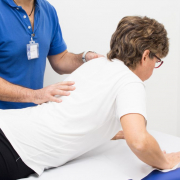Scoliosis: situations to beware of in adulthood
The importance of keeping scoliosis under control through regular specialist check-ups is well known, and this is also true in adulthood when the condition can continue to evolve, albeit slowly and gradually (by half/one degree per year according to the literature).
Although curves measuring less than 30° are unlikely to progress (and a progression becomes less and less likely the further below this threshold the measurement is), curves greater than 50° will often worsen in adulthood. Accordingly, the frequency of medical check-ups is decided by the specialist on the basis of the individual patient’s clinical situation.
Idiopathic scoliosis – the form most frequently found in children and adolescents – affects females in particular. It is important to remember that there are certain times in the life of an adult woman when her body undergoes major transformations that make it necessary for her to take particular care of her back.
The first is pregnancy: it was once thought that scoliosis was most at risk of worsening during pregnancy, due to the body’s production of the hormone relaxin in preparation for childbirth; it was thought that this hormone, in addition to softening the ligaments of the pelvis ready for delivery, also had the same effect on the ligaments that help to support the spine, thereby temporarily reducing the level of trunk support.
Now, however, it is understood that the postnatal period and early months in the child’s life are the trickiest time for the mother. Indeed, in the first year of life, babies often need to be held or carried, and in the space of just a few months, they become considerably heavier. Furthermore, as they learn to walk, the mother often finds herself having to adopt a forward bent position. Obviously, all this can have a negative effect on the back, affecting posture and giving rise to pain. At the first sign of back support problems (pain, difficulty getting through the day, frequently needing to lie down), women with scoliosis, particularly if it is a severe form, would be well advised to do specific self-correction exercises prescribed by an expert physiotherapist; these exercises strengthen the back and help it to support the spine.
Finally, in menopause and beyond, the clinical situation is at increased risk of sudden worsening.
The body changes and the aging process, which accelerates with the onset of the menopause, can cause a worsening of existing curves and even the appearance of new ones, so-called de novo scoliosis.
Although men are less often affected by idiopathic scoliosis and are of course spared the major physical and hormonal changes that women go through, they are just as likely as women to experience aging-related scoliosis.
This form can cause postural imbalances severe enough to leave the affected individual with marked forward and/or lateral flexion of the trunk.
In this stage of life, a specialist medical examination is warranted in the presence of the following: onset of pain, an increasingly bent posture, worsening of postural asymmetries, loss of height, and difficulty supporting the trunk, relieved only when lying down.

